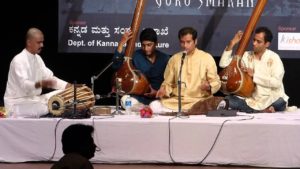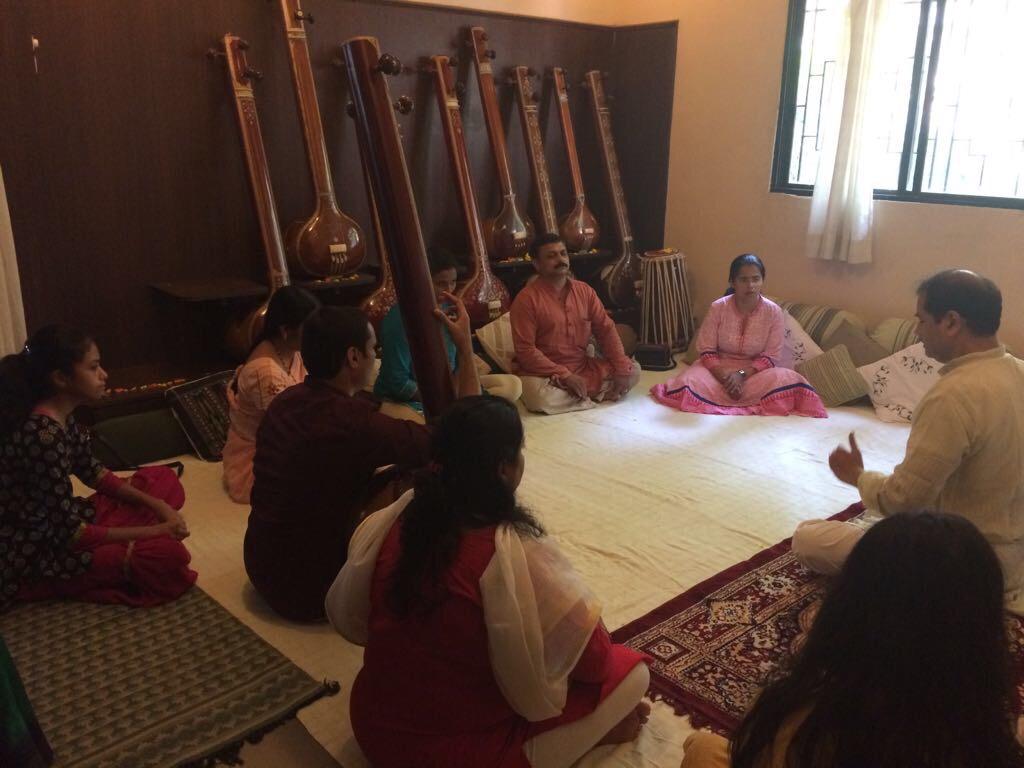PANDIT UDAY BHAWALKAR…in dialogue with…SUBHADRAKALYAN
— Reading Time: 30 Min Approx
DHRUPAD
Through an extensive conversation, we have come to know about how Uday Dada was introduced to Dhrupad. This particular genre of vocal music that Uday Dada has learnt, practiced, performed and taught all his life, is surely one of the most extraordinary ones. In this segment of my conversation with Uday Dada, we would come to know what Dhrupad really is.
What really is Dhrupad?
“For me, Dhrupad is the only language that I know. It is a form of art which involves both vocal music and instrumental music. The traditional practice of playing Alaap and Jod in an instrument has actually originated from Dhrupad.
Structurally, Dhrupad comprises of Alaap and Bandish. Above this, if I am to tell you what Dhrupad really is, I would say, it is a milestone of Indian music. It is a proof of the civilization of Indian music.
In the earlier times when Dhrupad was yet not there, Chhanda Prabandha would be sung in the language, Sanskrit. They would be recitations of shlokas or verses in the languagewith no definite cycle of the Taalas. I remember, I once heard it in Vrindavan. There would be eighteen to twenty verses to be recited.
But, with the arrival of Dhrupad, the Taala system too appeared to be prevalent in Indian music. With the introduction of the Taala system, the system of cycles too was introduced. The system of cycles is very important in music; it gives you the fun to come back to the first beat, the Sam, within the allotted time. With all these, there emerged a particular treatment of the tones.
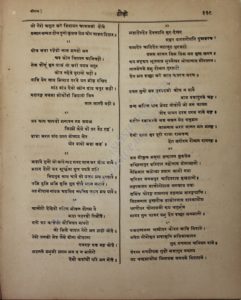
In India, even before the tradition of Chhanda-Prabandha, some particular development of tonic systems took place. The song with one tone was called Archika; the one with two tones, Gathika; the ones with three tones, Samika; the one with four tines, Swarantara. The ones with five tones onwards were called Ragas. But then again, we have a raga, Malashree with three tones and the raga, Hindol with four tones. The emergence of Dhrupad as a genre of music helped the further developments of melodies with practical use of these tones.
There is an old saying in India that all forms of music actually arrived from nature. It’s quite true. During the early periods of civilization, people stayed in the jungles, wore whatever they wanted and ate whatever was available. When they adapted to the country life, they started to wear proper clothes, started eating proper food. Back then, during the time of primitive life people would communicate with one another with a particular form of music, that sounded like – Huh – Huh – – Huh – Huh – -. I particularly presume, it is from this kind of music, the particular tonic systems I mentioned above originated. It would just be a civilized format of the sound that would accord to a particular pitch thus developing the tonic systems. We must also remember the fact there were the sages who practiced music. I again presume, these sages belonged to a period of time that was in between the one of the primitive life and the one of the country life. They are said to have witnessed the transition. It’s them who worked a lot on the tonic systems.
After the arrival of Dhrupad where the tones would be sung independently, the system of syllables was introduced. So far as I believe, these syllables – Aa, Ra Na Naa, Ra Na, Noom Na, Te Ta Ra Na Naa, Ree Naa Ra Na Naa – were actually derived from the Sanskrit Mantra, Om Ananta Hari Narayana and were introduced to music by the sages. But who knows if the Mantra did not originate through civilization. There must have been some earlier form of the language as well. With the passage of time, things developed into being civilized and some kind of new things kept on to be added.”
Now, I must ask you the most important question. I remember I have asked you this even before. There are so many syllables sung in Dhrupad. What is the process through which you arrange the syllables? Last time when you were teaching me Alaap in the raga, Bhoop, you arranged the syllables on your own. I just want to ask, how you put them together in an organized manner.
“There is no particular order or technique to arrange them. There is a particular perception of individual artistes as to what syllable comes after what syllable. This perception varies from person to person. An important matter is how the syllables sound together. If I sing (sings) Te—Re—, it would not sound good for me. But, if I sing (sings) Te—Ta—Ra—Na—Naa——-Ra—Naa——-, it would sound good. One must see the raga one is singing. The arrangement of the syllables also depends upon the movement of the raga.
One must also keep in mind the grammar of the language, Sanskrit, too. The syllables having been originated from the vowels of the language, hold a great correspondence with the fact of their resemblance with the vowels and their subsequent application greatly depend upon it. When one elongates a tone, one could use syllables like Aaa/Naa, Ree, Noom, as these resemble the vowels, आ/ā, ई/ī and ऊ/ū. The corresponding short form of the long vowel आ/ā have its similarity in the pronunciation of the syllables A, Ra, Na and Ta, resembling the vowel अ/a.
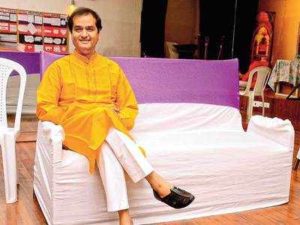
When I sing, I hardly make repetition to keep the novelty of the system.
This is something one develops in one’s journey through learning it, singing it and teaching it. It is actually not that much to be thought about. There are certain things which are to be let grow on their own. Even, I did not think about it much.”
Is it that, you first followed what your Guru instructed you to do and by that you developed an idea as to how your Guru arranged it and then when you moved to sing and then teach, you yourself started to find out your own ways through the ways your Guru sang?
“Now you have got it!”
Do these syllables mean anything if uttered independently?
“They must carry some meaning or the other. The scholars of Sanskrit consider them to be meaningful. Ta might mean something independently. Ra can also mean something. But when they apparently don’t seem to mean anything, they must be arranged and sung in such a way that what one is singing sounds good. One should feel good oneself while singing it. If you are talking about the logic behind such an arrangement, I shall say, it could be understood while singing. When you will sing, you will yourself find the logic behind your way of arrangement as to what syllable you will use to sing a particular tone, how you will pronounce it. A particular raga demands a particular use of a particular tone. In that case, you must see if you are adhering to the demands of the raga, the significance of the tone you are singing; you must make the syllable you are using quite justifiable for that particular tone. Logic itself will become logic then.”
Is this arrangement of the syllables changeable if the raga changes?
“Yes, of course. The arrangement also changes within the same raga when the phrase changes. It depends upon the wish of the musician. If one wants to emanate a particular mood through his expression, one would pronounce the syllables accordingly. If you are singing, your expression and way of pronouncing the syllables would change if your mood varies. If you want to express Shringaar Rasa, your expression would be different from how your expression would be when you would want to express Karuna Rasa, right? But in that case, you must be well aware of the emotions. You never can substitute your emotion with the tones or the syllables. You can only underline your emotions with the tones and the syllables.”
Is it possible to bring about all the nine moods or the Rasas in one single raga?
“It is possible to bring about all nine of them within one single tone. It just depends on how you sing it. I don’t quite agree to the notions, the raga Todi belongs to Karuna Rasa, the raga, Yaman belongs to Shant Rasa or the raga, Darbari Kanada belongs to Veera Rasa. These conclusions are actually stamps tagged to the ragas. It’s not that there isn’t any impact that a raga creates. It does. But, then again, the emotion builds up basing upon the imagination of who is singing and how it is being sung. If you are singing and perceiving it that way, you can actually introduce Shringaar Rasa in the raga, Todi too. It’s all about the individual perceptions one has.
Now, after the Alaap, there is the Jod.
When I am singing the Alaap in the raga, Yaman, and I am at first concentrating on Shadja and Nishad or the tonic and the leading note of previous octave, prioritizing them over the other tones and elaborating upon them. All that I am doing, I am doing without an apparent application of rhythm.
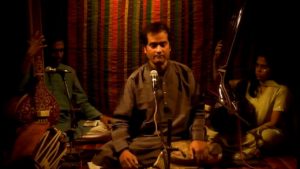
Singing the Jod came from the ideas of the same people who shall have paved the way for the Alaap to be a prominent part of Dhrupad. What happens in the Jod is that, the tones and the arrangement of them, the syllables, remain all the same as the Alaap, but the treatment differs. A particular rhythmic pattern of two followed by two is added to it as well.
When I sing the Alaap, I am often compelled to wonder as to how a tone could be so deep. Each time I sing a tone, I feel like sinking into its depth. It feels like sinking into the sea; and somewhere I enjoy this feeling, for, it’s so pure! I do keep my imagination alive but at the same time, I keep listening to the Tanpura as well as I am conscious, I am not deviating from the conventions. The scope for introspection in the Alaap is more, for it has no apparent rhythmic bindings.
While singing the Jod, with the use of a particular rhythmic pattern and more syllables, we are given the range of contemplation to such an extent that, with the use of more syllables to sing one particular tone, we are able to sink deeper into the tone reaching the microtones. At some level, the particular tone that I singing becomes my friend. We laugh, we play together. This brings about the main motive of friendship; getting to know your friend better; when I get to know more and more about the tone I am singing.
After the Jod, comes the Jhala, where the rhythmic pattern develops into a one of four followed by four. This increases the tempo.
In our country, just after the art of singing gained prominence, there emerged the tradition of playing the Veena. I presume the conventions of the Jod and the Jhala appeared from the ways of Veena.
The Jod and the Jhala were mostly parts of the Alaap. The compositions, the Bandish, were a separate department.
The compositions that would be sung would be sung in moderate tempos. If sung too fast, the melody would be compromised. If sung too slow, the meaning of the lyrics would be compromised. The compositions would actually be pieces of poetry. One would be careful, one was able to convey what the composition meant both literally and musically. Some people neglect the lyricism of the fixed compositions, and prioritize more on the convention of singing the raga. For me, the melody is of supreme importance, but that doesn’t mean, the compositions would not be important for me.
From the exam’s point of view, the one who can stay true to the convention will be awarded with more marks than the one who will sing more fixed compositions.
The Bandish is not limited, but after a point, you will not be able to expand it beyond what is described in it. Whereas, singing the Alaap doesn’t get you limited in any way. The syllables might not mean anything apparently, but you can instill meaning in them while singing. That might provide you with a vast range of imaginations so much so that you are able to put your imaginations in every way possible.”
How does Dhrupad impact your mind and your daily lifestyle?
“I can say, having practiced Dhrupad I have turned into a sensitive, peace-loving person. One other thing that I have learnt from the movements of Dhrupad is that being contemplative about things. The Alaap taught me to see things deeply. I admire the innumerable spaces I am left to discover within one single tone while singing the Alaap. That has impacted my thought process quite intensely.”
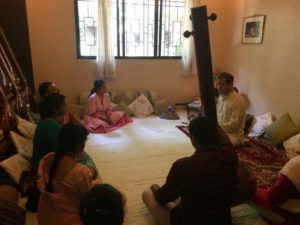
Uday Dada’s younger daughter, Meghana, a teenager, was around, seriously listening to the conversation. I have been seeing her ever since her childhood. I have even seen Uday Dada’s elder daughter, Manasi, a renowned theater personality of Maharashtra. Whenever Uday Dada came to Kolkata, he would bring Manasi, and then after a few years Meghana too, with him. We kids, who learned from him together, made good friends with each other.
I often wondered how Manasi and Meghana were influenced by such divine music of their father and how his music contributed to their growth as the true human beings they are today. My next question was to both Uday Dada and Meghana.
How does Dhrupad help children grow up?
“I think, Meghana should answer first.”
Meghana: I don’t know about the other teenagers, but since he is my father, and I have been exposed to his music since my birth, I think I know what depths it could go to. His music influences me so much that I start singing unknowingly whatever I hear him sing. But he also teaches me what’s within what he is singing and how I should improve. There is actually a lot to learn and one can never be contended.
How do you identify yourself with his music?
Meghana: I try every other way to reach out to his music. Even unconsciously, I find myself immersed into his music. The music I normally hum is what I am hearing him teach his students.
PUB: “Yes. Yesterday, I was teaching my students the raga, Chhayanat, and later, I found she was humming the thing I was teaching them.
Let me tell you something that I saw quite closely. When my elder daughter, Manasi, was three years old, me, my wife, Jyoti Bhawalkar and Manasi, went to Khadakwasla Dam, just spend a couple of hours experiencing nature.
I drove them to the dam with my scooter. My wife was standing near the scooter while I took Manasi to the water. Upon returning, I was informed by my wife that, several boys were playing around and were discussing what music they listened to, and one boy took my name and mentioned the record that was released a few days aback since then. She also told me that she heard him say that he could study well while he listened to my music and that he would like the part ‘the drum was not being played with music,’ which means, he referred to the Alaap.
I performed at several schools while touring for the Spic Macay concerts. Later when those little kids met me abroad, some studying in universities, some getting settled there, they told me they remembered and cherished the experience of hearing me sing when they were all kids.
I can tell you one more incident that happened. Once I received an email from a person who was informed by the doctor, he would live just a couple of years more. But he wrote to me, having heard me sing, he hoped to live for ten more years.”
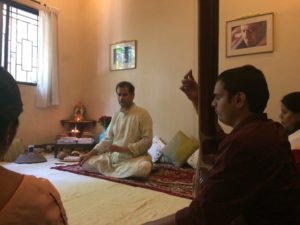
Do you think the people of the present generation would learn Dhrupad?
“They are learning Dhrupad but compared to the number of people learning the drumming instruments the number of the ones learning Dhrupad is less. This might be because, a general human being is more attracted towards rhythm than melodies. This is nothing to complain about. This is only natural since the beginning of the development of mankind.
The other thing that might be the reason is that the convention of playing the drumming instruments is much less limited than the one of singing. There were conservative people who were not in favor of expanding the horizon in the field of singing. But on the contrary, suppose in case of playing the Tabla, one could gather more and more of information and assimilate them together and play them before the audience. The cultivation is more. The horizon is broader. The popularity is greater.”
He stopped. This remains the most important of the episodes of this interview, for this will give the readers a deep insight into what Dhrupad is and how it impacts one’s life.
